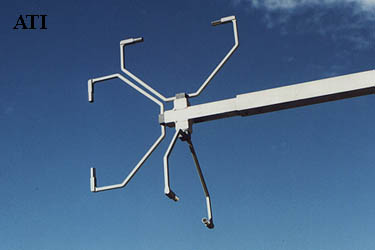|
Sonic Anemometer - Gill r3 and ATI
  A sonic anemometer determines instantaneous
wind speed and direction (turbulence) by measuring how much sound
waves travelling between a pair of transducers are sped up or
slowed down by the effect of the wind. It has many applications
such as studying atmospheric turbulence, monitoring air pollution,
measuring evaporation and even indoor ventilation problems.Short
pulses of ultrasonic sound are exchanged on three different directions
by couples of sound probes which are used alternately as transmitting
and receiving units. Combining the sound velocities of different
propagation directions, the 3-dimensional wind vector can be
determined. Furthermore, the sound velocity in a motionless atmosphere
is derived which corresponds to a measurement of the virtual
temperature. The sound velocity depends not only on the temperature,
but also on humidity.Therefore, the measured temperature represents
the virtual temperature which is needed for most investigations
of atmospheric stratification. A sonic anemometer determines instantaneous
wind speed and direction (turbulence) by measuring how much sound
waves travelling between a pair of transducers are sped up or
slowed down by the effect of the wind. It has many applications
such as studying atmospheric turbulence, monitoring air pollution,
measuring evaporation and even indoor ventilation problems.Short
pulses of ultrasonic sound are exchanged on three different directions
by couples of sound probes which are used alternately as transmitting
and receiving units. Combining the sound velocities of different
propagation directions, the 3-dimensional wind vector can be
determined. Furthermore, the sound velocity in a motionless atmosphere
is derived which corresponds to a measurement of the virtual
temperature. The sound velocity depends not only on the temperature,
but also on humidity.Therefore, the measured temperature represents
the virtual temperature which is needed for most investigations
of atmospheric stratification.
The sonic offers several major advantages over cup anemometers
and bivane systems. Since there are no moving parts to come into
dynamic equilibrium with the airflow, the sonic responds rapidly
to wind velocity fluctuations. It responds linearly to wind velocity
and is free from contamination from other velocity components
as well as pressure, temperature, and relative humidity. The
calibration of the sensor is established by its design parameters
and, therefore, can be used as an absolute instrument. |

 A sonic anemometer determines instantaneous
wind speed and direction (turbulence) by measuring how much sound
waves travelling between a pair of transducers are sped up or
slowed down by the effect of the wind. It has many applications
such as studying atmospheric turbulence, monitoring air pollution,
measuring evaporation and even indoor ventilation problems.Short
pulses of ultrasonic sound are exchanged on three different directions
by couples of sound probes which are used alternately as transmitting
and receiving units. Combining the sound velocities of different
propagation directions, the 3-dimensional wind vector can be
determined. Furthermore, the sound velocity in a motionless atmosphere
is derived which corresponds to a measurement of the virtual
temperature. The sound velocity depends not only on the temperature,
but also on humidity.Therefore, the measured temperature represents
the virtual temperature which is needed for most investigations
of atmospheric stratification.
A sonic anemometer determines instantaneous
wind speed and direction (turbulence) by measuring how much sound
waves travelling between a pair of transducers are sped up or
slowed down by the effect of the wind. It has many applications
such as studying atmospheric turbulence, monitoring air pollution,
measuring evaporation and even indoor ventilation problems.Short
pulses of ultrasonic sound are exchanged on three different directions
by couples of sound probes which are used alternately as transmitting
and receiving units. Combining the sound velocities of different
propagation directions, the 3-dimensional wind vector can be
determined. Furthermore, the sound velocity in a motionless atmosphere
is derived which corresponds to a measurement of the virtual
temperature. The sound velocity depends not only on the temperature,
but also on humidity.Therefore, the measured temperature represents
the virtual temperature which is needed for most investigations
of atmospheric stratification.